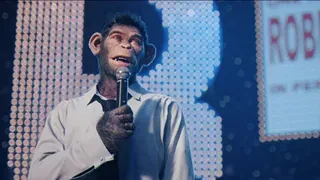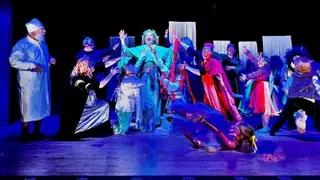September 11, 2012
Reclining Nude on La Cienega
Tatum Regan READ TIME: 4 MIN.
Jann Karam's solo show, "Reclining Nude on La Cienega," is not on La Cienega, nor does it feature any nudity. (Karam does, however, spend some time reclining on a paint-smattered, canvas-covered chaise.) Midway through the performance, Karam explained the origin of the title while describing her experience advertising for the show.
Men, and her mother, had seen the flyers and wondered how clothed Karam would be. No nudity, she had said; it's a reference to Duchamp's "Nude Descending a Staircase." One brutish fellow she encountered disappointedly replied, "You can't jerk off to a metaphor," to which his more open-minded friend responded, "Yes, you can."
Similar anecdotes involving men, and lewd men, in particular, abound throughout the show, some stories staying on the lighter side and others depicting especially grim manifestations of patriarchy. One of the autobiographical show's major themes is a doomed cycle in which Karam repeatedly seeks love from men that are as emotionally stunted as her father and brother had been. She describes this tendency as her Achilles' heel, and one particularly unsavory ex-lover actually receives the dubious honor of being referred to as "Achilles" in stories.
Duchamp is not the only artiste to get a shout-out from Karam. Throughout "Reclining Nude," she cites other artsy-thinker types as further inspiration, and the show's entire narrative arc is billed as a sort of hero's journey, � la Joseph Campbell. The Duchamp-Campbell conceptual combo could, in theory, work for Karam. "Nude Descending a Staircase" is a fitting, if ambitious, analogue to the performance: through experimentation, Duchamp endeavored to depict human movement.
Likewise, Karam has sought to explore beyond her standup-comedy background, using the combined media of theater and live painting to depict her own movement: her own ever-continuing "heroine's journey." But situated amongst Campbell, Duchamp, and Achilles' Greeks, Karam had a little too much to live up to, and her standup comedy background came through as both a blessing and a curse.
Undoubtedly, she worked the audience, and what was often somewhat depressing material was handled relatively lightheartedly. She moved around the stage with ease, improvising her way through any blunders and maintaining a brand of self-deprecation that is often a characteristic of standup comedy. But the anecdotes were too disjointed, often just sharing the motif of crappy boyfriends, and the building up of theme too unfocused to really achieve the chef-d'oeuvre Karam seems to have envisioned.
That being said, though Karam may not have quite achieved the lofty task she had set for herself, what she was able to achieve was undeniably charming, dynamic and certainly worth a visit to the theater. Approaching the lobby of Lillian Theatre (of Elephant Stages) from the street, one was met by an artist's workspace: paint-splashed chairs, canvases, and a stepladder.
The theater itself was set up like an artist's loft-studio, the high brick walls and exposed wood beams pairing beautifully with the set designed by Adam Hunter and ElephantStageworks. Four massive blank canvases were arranged on stage with a few ladders, independently hanging windows, and a centrally located chaise with an adjacent stack of earmarked, well-loved books, presumably Karam's own. Suspended from the wood-beamed ceiling were clusters of white, upside-down umbrellas that, throughout the show, would gently filter light of varying colors. (Karam's intermittent descriptions of her childhood dream, a life-affirming vision of a utopian artists' colony, were accompanied by blue light, like the night sky.)
When Karam arrived on stage, it was with a burst of frenetic energy that, quite admirably, would be maintained throughout the performance. Bright and earnest at the front of the set, dressed in paint-smudged white garb, and grinning and bouncing on the balls of her bare feet, she immediately established a childlike presence; following her d�but with a wiggling, shimmying dance furthered the impression.
It seemed quite natural, then, when Karam took up a broad paintbrush, dipped it in beige, and began describing her childhood in the desert of Superior, Arizona in large strokes and simple, charming monologue. ("Superior to what?" Karam wondered aloud.) The beige color scheme that dominated at the show's beginning gave way, over the course of the performance, to red, blue, black, yellow, green, orange, peach and so on, until the canvases and Karam were awash with color. As she narrated events from her life, Karam punctuated particularly climactic or salient moments with paint strokes, slaps, smacks, and even stomps.
Though Karam was never fully successful in tying together the disparate threads of her life story (a difficult task, to be sure), audience reaction was evidence enough that she could win over a crowd. The same moments she punctuated with paint strokes were often punctuated by sighs, and gasps and "no!"s from audience members. Responses occasionally veered too closely towards sympathy, rather than empathy.
There seemed to be some distance between Karam and her material, partly due to her casual, standup style, but, undoubtedly, the audience felt for her, even if it could not quite feel with her. Karam set herself an audacious goal, and though her portrait never fully came to life, one couldn't help but be charmed.







